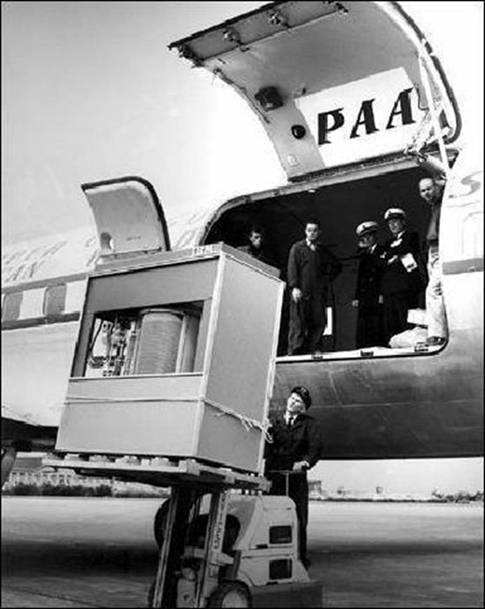Check out the photo below… It’s a hard disk drive back (HDD) in 1956… on a lift, being taken across the country in an airplane’s storage bay. As big as it was, it had only 5 MB of storage. In September 1956 IBM launched the 305 RAMAC, which was the first ‘SUPER’ computer ever to have an HDD. It weighed over a ton. And it was amazing.
Recently (Oct 2010) Apple introduced it’s new line of MacBook Air laptop computers. They weigh almost nothing and contain a Solid State Drive for storage. Solid state drives are just big memory chips and do not have any moving parts, making them faster, run cooler, and lighter in weight. They are, however, still pretty expensive. The top-of-the-line MacBook Air comes with 256 Gigabytes of storage, a mere 52,428 times the capacity of the HDD shown below.
According to Wikipedia, Moore’s law describes a long-term trend in the history of computing hardware. The number of transistors that can be placed inexpensively on an integrated circuit has doubled approximately every two years.[1] The trend has continued for more than half a century and is not expected to stop until 2015 or later.[2]
The capabilities of many digital electronic devices are strongly linked to Moore’s law: processing speed, memory capacity, sensors and even the number and size of pixels in digital cameras.[3] All of these are improving at (roughly) exponential rates as well.[4] This has dramatically increased the usefulness of digital electronics in nearly every segment of the world economy.[5][6] Moore’s law precisely describes a driving force of technological and social change in the late 20th and early 21st centuries.
The law is named after Intel co-founder Gordon E. Moore, who described the trend in his 1965 paper.[7][8][9] The paper noted that number of components in integrated circuits had doubled every year from the invention of the integrated circuit in 1958 until 1965 and predicted that the trend would continue “for at least ten years”.[10] His prediction has proved to be uncannily accurate, in part because the law is now used in the semiconductor industry to guide long-term planning and to set targets for research and development.[11] This fact would support an alternative view that the “law” unfolds as a self-fulfilling prophecy, where the goal set by the prediction charts the course for realized capability.


You must be logged in to post a comment.